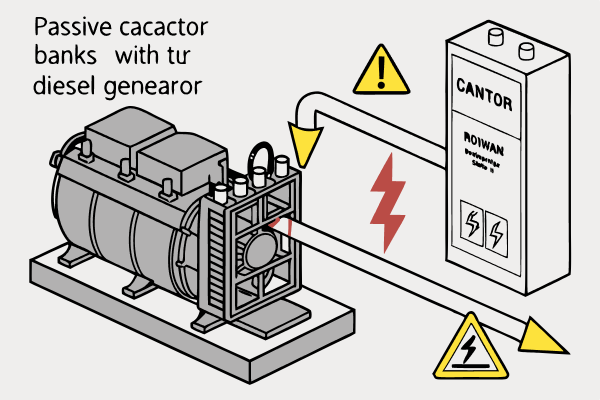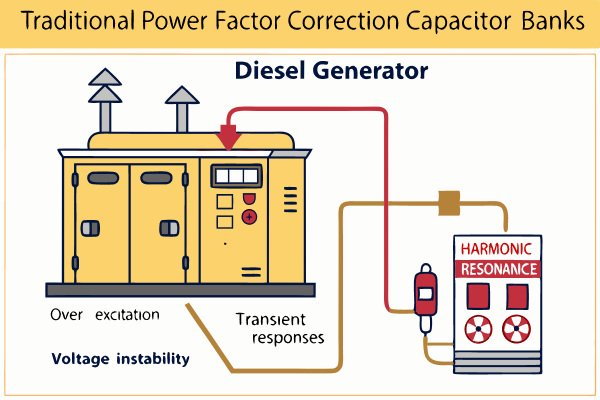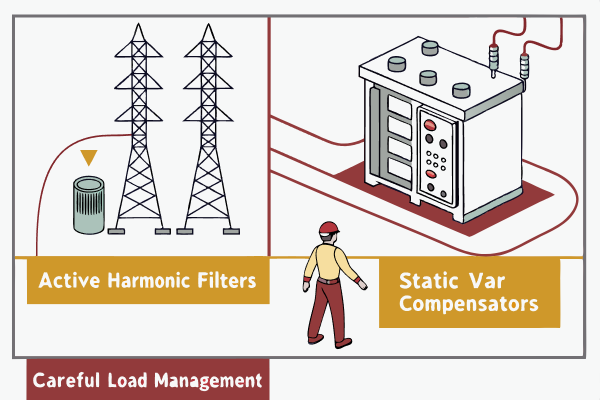
Trying to fix power factor with a capacitor bank on a generator? This can cause big problems.
Connecting traditional power factor correction capacitor banks directly to a diesel generator is often avoided due to potential issues like voltage instability, harmonic resonance, over-excitation, and difficulty managing transient responses.
It seems simple.
But generators are different.
What are the specific technical risks or operational issues that arise from connecting traditional power factor correction capacitor banks to a diesel generator system?
You want better power factor. You think a capacitor bank will help. What goes wrong when you hook it up to a generator?
Connecting passive capacitor banks to a diesel generator can cause voltage control problems, lead to harmonic resonance issues, and sometimes make the generator unstable.

Understanding the Problems
When you connect a fixed capacitor bank to an electrical system, it provides reactive power. This helps improve the power factor, which is good on a large utility grid. But a diesel generator is a different power source than the grid. The grid is very large and stable. A generator is smaller and its voltage and frequency are controlled dynamically by its internal systems (voltage regulator and governor). Capacitor banks provide a fixed amount of reactive power. This fixed amount interacts poorly with the generator's dynamic control. One big issue is over-excitation. A capacitor bank adds leading reactive power. The generator's voltage regulator works to keep the output voltage steady. If the capacitor bank is too large or the load changes, the generator might see the leading reactive power from the bank as the voltage being too high. Its voltage regulator might try to lower the voltage by reducing excitation. This can lead to the generator becoming over-excited or unstable, sometimes causing the voltage to swing wildly or even trip the generator offline.
Another serious problem is harmonic resonance. Electrical loads in modern systems, especially electronics and variable speed drives used in many facilities (like those found in restaurants or data centers), create harmonics. These are unwanted frequencies alongside the standard 50Hz or 60Hz. A capacitor bank, when combined with the generator's inductance and the system's wiring, can create a resonant circuit. This is like a tuning fork that vibrates strongly at a specific frequency. If that resonant frequency matches one of the harmonic frequencies in the system, the harmonics can be greatly amplified. High levels of harmonics can cause overheating in cables, transformers, and rotating machinery (including the generator itself), lead to malfunction of sensitive electronic equipment, and inaccurate meter readings. This is a hidden danger that can cause long-term damage. We see this risk when clients consider adding standard capacitor banks. It's not a good match for the generator's characteristics.
Major Risks of Capacitor Banks with Generators
- Voltage Instability1: The fixed reactive power from the bank fights with the generator's voltage regulator, causing voltage fluctuations.
- Over-excitation2: Excessive leading reactive power can trick the generator's regulator into reducing excitation too much, risking damage or shutdown.
- Harmonic Resonance3: The combination of generator, wiring, and capacitor bank can amplify harmful harmonic frequencies present in the system.
- Load Hunting: The generator's governor and voltage regulator can struggle to find a stable operating point with the capacitor bank connected, causing the engine speed and voltage to oscillate.
- Transient Issues: Switching the capacitor bank on or off can cause large, sudden voltage spikes or dips that stress equipment.
- Reverse Power: If the load drops significantly while the capacitor bank is connected, the bank can push power back towards the generator, which is very bad for the generator.
For project execution entities or distributors providing power solutions, these risks are significant. A generator failure due to unstable voltage or harmonics is unacceptable, especially in critical applications like hospitals or data centers, where our H&C generators are often used. The cost of a generator failure is much higher than the cost of the capacitor bank. Unlike the utility grid, a generator has limited capacity to absorb the reactive power from a capacitor bank. My experience talking with engineers is that trying to use traditional, fixed capacitor banks with generators is a gamble that usually is not worth the potential problems. It is much safer to use alternative methods designed to work with the dynamic nature of a generator power source.
| Technical Issue | Why Capacitor Banks Cause It | Potential Consequence |
|---|---|---|
| Voltage Instability | Fixed VARs interfere with dynamic regulation | Voltage swings, equipment malfunction |
| Harmonic Resonance | Create resonant circuit with system inductance | Equipment overheating, failure, system disruption |
| Over-excitation | Leading VARs make voltage control difficult | Generator tripping, potential damage |
| Load Hunting | Control systems struggle to stabilize | Unstable voltage/frequency, wear on engine |
| Transient Voltage Swings | Sudden switching of reactive load | Stress on insulation, equipment damage |
| Reverse Power | Bank pushes power back at low load | Generator damage |
So, connecting a capacitor bank creates several serious technical problems because the generator is not as stiff or large a power source as the main utility grid.
What alternative methods or technologies are used for power factor correction in electrical systems primarily powered by diesel generators, instead of passive capacitor banks?
Capacitor banks are risky with generators. What else can you use to fix power factor in a system running on a generator?
Instead of passive capacitor banks, alternative power factor correction methods like active harmonic filters, static VAR compensators (SVCs), or careful load management are preferred for systems powered by diesel generators.

Better Ways to Fix Power Factor
Since traditional capacitor banks cause problems with generators, other technologies are used. These methods are designed to work better with a generator's characteristics. One alternative is using active power factor correction devices. These devices are much smarter than simple capacitor banks. They monitor the load and the generator's output in real-time. They use power electronics to inject reactive power (and sometimes actively cancel harmonics) into the system precisely when and where it is needed. Unlike a fixed capacitor bank that provides a constant amount of reactive power regardless of the load, active systems adjust their output dynamically. This means they do not fight with the generator's voltage regulator and they can provide the right amount of reactive power needed by the changing load. Active Harmonic Filters (AHFs) are a type of active system that not only correct power factor but also actively reduce harmful harmonics. They sense the distorted current caused by loads and inject a compensating current to cancel the harmonics out.
Another technology used is Static VAR Compensators (SVCs) or similar static compensators (STATCOMs). While sometimes used on utility grids, smaller versions exist for industrial applications. These also use power electronics to provide reactive power. They are more dynamic than capacitor banks and can respond faster to changes in the load. They can provide both leading and lagging reactive power as needed. For project execution entities needing sophisticated power management, these active or static systems offer much better performance and stability than passive capacitor banks. A simpler, but often effective, approach is load management. This means carefully selecting and operating loads to minimize reactive power demand. For example, using high-efficiency motors or variable speed drives with built-in power factor correction. It also means avoiding running equipment unnecessarily that has a poor power factor. At H&C, we configure our generators with robust voltage regulation systems, but they still need compatible loads. We advise clients on system design to minimize issues, including recommending against passive capacitor banks and suggesting these alternative solutions or load management strategies if power factor correction is critical for their application, such as data centers or industrial plants where efficiency is paramount.
Alternatives for Power Factor Correction with Generators
- Active Harmonic Filters (AHF)4: Dynamic devices that provide reactive power correction and also cancel harmonics.
- Static VAR Compensators (SVC/STATCOM): Power electronic-based systems providing dynamic reactive power support.
- Synchronous Condensers: Essentially synchronous motors running without mechanical load, used for large-scale reactive power control (less common for smaller genset systems).
- High Power Factor Equipment: Using motors, VFDs, and other equipment that have built-in power factor correction or naturally high power factors.
- Load Management5: Strategically operating loads to reduce overall reactive power demand.
These methods are more complex and often more expensive initially than a simple capacitor bank. But the improved stability, reduced risk of equipment damage, and better interaction with the generator make them a better investment for reliable power, especially for critical applications our clients are involved in. For distributors offering complete power solutions, understanding these alternatives is key to providing reliable systems. My experience confirms that systems using these dynamic correction methods are much more stable and perform better when powered by a generator compared to those with passive capacitor banks.
| Alternative Method | Technology Type | Key Advantage with Generators | Typical Application |
|---|---|---|---|
| Active Harmonic Filter (AHF) | Power Electronics | Dynamic correction, Harmonic cancellation | Systems with many non-linear loads (VFDs, electronics) |
| Static VAR Compensator (SVC) | Power Electronics | Dynamic reactive power support | Industrial sites with rapidly changing reactive loads |
| High PF Equipment | Equipment Design | Reduces VAR demand at the source | New installations, equipment upgrades |
| Load Management | Operational Practice | Reduces overall VAR demand | Any system, requires operational discipline |
So, dynamic electronic systems or careful load selection are better ways to manage power factor when using a generator. They work with the generator, not against it.
How does the transient response or voltage regulation characteristic of a diesel generator interact negatively with the switching or fixed reactive power contribution of a capacitor bank?
Generators react to changes. How does their reaction mess up when a capacitor bank is connected or turned on?
A diesel generator's voltage regulation6 system and its transient response7 struggle to handle the sudden, fixed reactive power from a capacitor bank, leading to over-voltage, instability, and oscillations.

Generator Response Issues
A diesel generator's main job is to produce stable voltage and frequency. Its Automatic Voltage Regulator (AVR) controls the excitation of the alternator to keep the output voltage constant, even as the load changes. The governor controls the engine speed to keep the frequency stable as the load changes. When a large load is suddenly connected (a transient event), the engine speed dips slightly, and the voltage also dips. The governor and AVR quickly react to bring them back to normal. This is the generator's transient response. Now, consider a capacitor bank. A capacitor bank provides leading reactive power. When you connect it, it immediately changes the reactive power balance in the system. Unlike resistive or inductive loads, which primarily draw real or lagging reactive power, the capacitor bank supplies leading reactive power. The generator's AVR sees this leading reactive power as the voltage increasing. It tries to counteract this by reducing the excitation. Because the capacitor bank provides a fixed amount of reactive power, it creates a constant "push" on the voltage that fights the AVR's efforts to regulate it based on the total load. This fight can cause the voltage to become unstable, oscillating above and below the target voltage.
Switching the capacitor bank on or off makes this even worse. Switching a capacitor bank creates a very sudden, step change in reactive power. This is a severe transient event, but it is reactive, not just real, load. When switched on, it injects a large amount of leading reactive power instantly. The generator's AVR, which is designed to respond to changes from loads, might overreact to this sudden reactive injection. This can cause a significant voltage spike. Conversely, switching it off causes a sudden drop in leading reactive power, which can also lead to voltage swings. These sudden voltage changes stress all connected equipment. Generators, being relatively small compared to the grid, have higher internal impedance. This higher impedance makes their voltage regulation more sensitive to reactive loads. A large, fixed capacitor bank can dominate the reactive load landscape, making it very difficult for the AVR to maintain stable voltage, especially as the real load varies. For our project procurement clients, they need generators that can handle project loads reliably. Adding a device that makes voltage control unpredictable defeats the purpose of having a stable power source.
Generator/Capacitor Interaction Problems
- Voltage Regulation Conflict: Generator AVR tries to maintain voltage by adjusting excitation; capacitor bank provides fixed leading VARs, conflicting with AVR control.
- Transient Voltage Swings: Switching the capacitor bank on or off causes abrupt changes in reactive power, leading to large voltage spikes or dips.
- Over-Voltage Risk: If the capacitor bank is too large, especially during light load conditions, the generator's voltage regulator may not be able to reduce voltage enough, leading to dangerous over-voltage.
- Oscillation: The generator's control systems (AVR and governor) can "hunt" for a stable point when interacting with the fixed reactive power, causing unstable voltage and frequency.
- Limited Reactive Power Absorption: Generators have limited capacity to absorb leading reactive power compared to a large utility grid. Exceeding this can cause damage or tripping.
This unstable interaction is why most generator manufacturers, including us at H&C, strongly recommend against using traditional, fixed capacitor banks for power factor correction on generators. The generator's design and control systems are optimized to handle varying lagging loads (like motors and inductive equipment). They are not designed to easily absorb large amounts of leading reactive power from capacitor banks, especially not in a sudden or fixed manner. The stability of the voltage and frequency is paramount for sensitive equipment and overall system health. Introducing a capacitor bank compromises this stability. It is a case where a solution for the grid causes problems for a generator.
| Generator Characteristic | How Capacitor Bank Interacts Negatively | Outcome |
|---|---|---|
| AVR (Voltage Regulation) | Fights with fixed leading VARs | Voltage instability, over-excitation |
| Transient Response | Reacts poorly to sudden VAR changes | Voltage spikes/dips on switching |
| Internal Impedance | Makes voltage more sensitive to VARs | Amplifies voltage swings, instability |
| Limited Leading VAR Limit | Cannot absorb excessive leading VARs | Generator damage, tripping, failure |
So, the way a generator controls voltage and reacts to sudden changes just does not work well with the fixed, often abrupt, reactive power from a capacitor bank. It creates instability.
Conclusion
Capacitor banks cause generator instability and risks; alternatives handle power factor better with generators.
-
Understanding voltage instability can help you avoid costly generator failures and ensure stable operations. ↩
-
Learning about over-excitation can help you maintain generator health and avoid operational risks. ↩
-
Exploring harmonic resonance can prevent equipment damage and improve system reliability in critical applications. ↩
-
Explore this link to understand how AHF technology can enhance power factor correction and reduce harmonics in generator systems. ↩
-
Discover effective load management strategies that can significantly reduce reactive power demand and enhance system efficiency. ↩
-
Understanding voltage regulation is crucial for ensuring stable power supply and avoiding issues with capacitor banks. ↩
-
Exploring transient response helps in grasping the generator's behavior during sudden changes, essential for system stability. ↩

